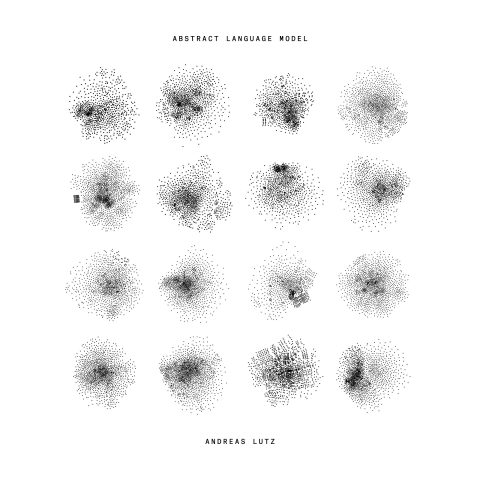Rozpocznę więc od drugiego dnia i drugiego występu OSA Festival. Andreas Lutz. Pamiętam ciszę, która zapadła na sali chwilę po uruchomieniu monumentalnych animacji towarzyszących niemieckiemu artyście. Cisza ta zdawała mi się czymś nietypowym jak na festiwalową publiczność. Na ekranie obok eksplozji barw znalazły się tajemnicze znaki – niby znajome kształty przypominające litery, a jednak w każdym z nich coś przestawiono, dodano, zmodyfikowano…
Czterdziestominutowy performans składał się w całości z najnowszego materiału Lutza. Abstract Language Model, wydany zaledwie kilka dni wcześniej, kryje w sobie pozorny chaos niezrozumiałego, mrocznego świata; chaos, którego lepka materia wciąga i nie pozwala wyjść z ruchomych piasków podświadomych lęków. Szerokie ambientowe krajobrazy i towarzyszące im hipnotyzujące mechatroniczne animacje sprawiły, że zafascynowana chłonęłam ten występ wszystkimi zmysłami. Nie ma jednak rzeczy przypadkowych – więź, którą poczułam z twórczością Lutza stała się oczywista, gdy zapoznałam się (jako pasjonatka inżynierii przetwarzania języka) z historią powstania i konceptem stojącym za Abstract Language Model. Opiera się on bowiem na wytrenowanej z użyciem wszystkich zestawów znaków reprezentowanych w standardzie Unicode sztucznej sieci neuronowej. Rezultat? Stworzenie abstrakcyjnego (a raczej – potencjalnego) transludzkiego, transmaszynowego języka, który umożliwiłby komunikację człowieka z maszyną.
Podmiotowość bytów nie-ludzkich pełni zresztą istotną rolę w twórczości Lutza, tak jak rozważania nad przyszłością komunikacji, podczas występu przyjmujące formę wyekstrahowanych wizualnie z istniejących systemów znaków i zwizualizowanych nie-liter. Muzycznie materiał Abstract Language Model rozwija się niespiesznie, korzystając obficie ze stereotypowych elektro-zgrzytów czy subtelnych dronów, jednak nawet pośród techno-pasaży było coś urzekająco pięknego w tym dźwiękowym świecie wyczarowanym za pomocą nauki i magii dokładnie na przecięciu istniejącego i potencjalnego.
— Natalia Glinka-Hebel via Glissando
The forty-minute performance consisted entirely of Lutz’s latest material. Abstract Language Model, released just a few days earlier, hides the apparent chaos of an incomprehensible, dark world; a chaos whose viscous matter draws you in and prevents you from emerging from the shifting sands of subconscious fears. The wide ambient landscapes and accompanying mesmerizing mechatronic animations made me fascinated to absorb the performance with all my senses. However, things don’t happen by accident – the bond I felt with Lutz’s work became obvious when I became familiar (as a passionate language processing engineer) with the history of the creation and concept behind the Abstract Language Model. This is because it is based on an artificial neural network trained with all the character sets represented in the Unicode standard. The result? The creation of an abstract (or rather – potential) transhuman, transmachine language that would enable human-machine communication.
The subjectivity of non-human entities, by the way, plays an important role in Lutz’s work, as do considerations of the future of communication, during the performance taking the form of visually extracted signs and visualized non-literals from existing systems. Musically, Abstract Language Model’s material unfolds unhurriedly, making abundant use of stereotypical electro-grinds or subtle drones, but even in the midst of techno-passages there was something captivatingly beautiful about this sonic world conjured by means of science and magic precisely at the intersection of the existing and the potential.
